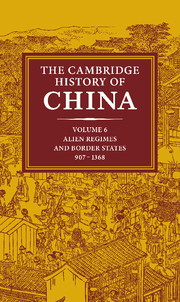Book contents
- Frontmatter
- Introduction
- 1 The Liao
- 2 The Hsi Hsia
- 3 The Chin dynasty
- 4 The rise of the Mongolian empire and Mongolian rule in north China
- 5 The reign of Khubilai khan
- 6 Mid-Yüan politics
- 7 Shun-ti and the end of Yüan rule in China
- 8 The Yüan government and society
- 9 Chinese society under Mongol rule, 1215–1368
- Bibliographical essays
- Bibliography
- Glossary-Index
- MAP 7. The Liao empire, ca. 1045
- MAP 12. The Hsi Hsia state, IIII
- Map 17. The Chin empire
- MAP 32. The Yüan empire">
- References
5 - The reign of Khubilai khan
Published online by Cambridge University Press: 28 March 2008
- Frontmatter
- Introduction
- 1 The Liao
- 2 The Hsi Hsia
- 3 The Chin dynasty
- 4 The rise of the Mongolian empire and Mongolian rule in north China
- 5 The reign of Khubilai khan
- 6 Mid-Yüan politics
- 7 Shun-ti and the end of Yüan rule in China
- 8 The Yüan government and society
- 9 Chinese society under Mongol rule, 1215–1368
- Bibliographical essays
- Bibliography
- Glossary-Index
- MAP 7. The Liao empire, ca. 1045
- MAP 12. The Hsi Hsia state, IIII
- Map 17. The Chin empire
- MAP 32. The Yüan empire">
- References
Summary
THE EARLY YEARS
In 1229, when Khubilai's uncle Ögödei, rather than his father Tolui, had been selected as the successor to Chinggis khan, it had seemed unlikely that Khubilai would play more than a subsidiary role in Mongolian history. Few could have foreseen that he would eventually become the most powerful figure in the Mongolian domains.
One of those who did was his remarkably competent and intelligent mother Sorghaghtani Beki. Like her near contemporary Eleanor of Aquitaine, Sorghaghtani raised four sons – Möngke, Khubilai, Hülegü, and Arigh Böke – who became monarchs. Both women dedicated themselves to their sons' careers and did not halt their efforts until their sons were enthroned. Sorghaghtani's contemporaries regarded her as one of the greatest women of her age. The Hebrew physician Bar Hebraeus, quoting a poet of his era, wrote about her that “if I were to see among the race of women another woman like this, I should say that the race of women was far superior to men.” Without her political savoir-faire and the training she provided them, her sons would not have succeeded in replacing the house of Ögödei as the main Mongolian royal line.
Sorghaghtani profoundly influenced her sons. First of all, she ensured that they were literate, an indispensable skill for those who aspired to rule a great empire. In addition, by her own example, she taught them some basic political principles. In her appanage in north China, for example, she did not exploit her Chinese subjects, nor did she plunder the region.
Keywords
- Type
- Chapter
- Information
- The Cambridge History of China , pp. 414 - 489Publisher: Cambridge University PressPrint publication year: 1994
References
- 8
- Cited by



